F-35C & Ford Carriers – A Wrong Turn For Navy: CNAS
Posted on

Modern carrier-based aircraft have much less range than Cold War predecessors (Melody Cook, Center for a New American Security)
WASHINGTON: The high-cost, high-controversy centerpieces for the future Navy fleet — the Ford-class aircraft carrier and the F-35C fighter — not only take it in the wrong direction, says a report out today. They double down on a strategic mistake made 20 years ago, when the Navy shortchanged range, argues Jerry Hendrix, a retired Navy captain now with the Center for a New American Security in a new study.
Only investing in new, unmanned aircraft with longer range — ideally launched off smaller, cheaper carriers — can restore the carrier’s relevance in the face of Russian and Chinese ship-killing missiles, Hendrix argues. Like a recent study from the Hudson Institute, Hendrix sharply criticizes the modern carrier air wing for being too short-ranged and argues the Navy’s UCLASS drone (Unmanned Carrier Launched Surveillance & Strike) should be optimized for long-range raids.

A Navy F-35C conducts its first-ever arrested landing aboard the carrier USS Nimitz
In fact, both studies were at least partially inspired by a public debate Hendrix had with one of the Hudson co-authors, Bryan McGrath, back in January. Unlike the Hudsonites, however, who stoutly defend big carriers in general and the Ford class in particular, Hendrix takes issue with the ships as well as the airplanes flying off them.
“I still think that the Ford is too damn expensive. I still think we can do aircraft carriers more cheaply,” Hendrix told me. And he’s hardly alone: The retired Navy pilot who chairs the Senate Armed Services Committee, John McCain, repeatedly has hammered the Ford program for being over budget and behind schedule. Hendrix notes that McCain himself flew off the USS Forrestal, considered America’s first modern “supercarrier” but still 20 percent smaller than the subsequent Nimitz class or the Ford (80,000 tons at full load versus 100,000).
Yet despite being smaller, the Forrestal launched larger, longer-ranged aircraft than carriers do today. McCain, for example, flew the A-4 Skyhawk, whose range exceeds both the current standard strike fighter, the F/A-18E/F Super Hornet, and the forthcoming F-35C. (Skyhawk combat radius: 550-625 nautical miles. Super Hornet: 500 nm. F-35C: officially 615 but Hendrix estimates, based on how the F-35A variant is falling short of its range spec, that the C will end up closer to 550). Other retired carrier aircraft had even longer ranges, the greatest being the A3D Skywarrior introduced in 1956, the largest plane ever to fly from a carrier and boasting an 1,800-nm combat radius.

Graphic courtesy of the office of Sen. McCain
So what does a 100,000-ton carrier get you? Potentially, more planes, but budget constraints mean Nimitzes carry a third less than their maximum capacity, said Hendrix. “You used to carry 90 airplanes and you’re carrying 62 — and the planes are smaller,” he told me. “If you’re willing to accept a 62-aircraft air wing…you don’t need 100,000 tons.”
If you are choosing between 100,000-ton carriers, what does a new Ford, at up to $13 billion, get you over a Nimitz, which averaged $4.5 billion? The Ford has all sorts of upgrades that reduce maintenance, reduce crew size, and — by the Navy’s estimates — reduce operating costs over the ship’s life. Operationally, however, its main emphasis has been on new catapults, arresting gear, deck layout, and radar to maximize the sortie rate, the speed at which aircraft can be recovered, refueled, rearmed, and sent out again. All told, these improvements are supposed to allow the Ford a sustained sortie rate of 160 per day, compared to 120 for a Nimitz. That’s a striking 33 percent increase. In terms of the number of aircraft that they can put on target over a 24-hour period, three Fords equal four Nimitzes.
The problem, said Hendrix, is that the carrier’s ability to generate sorties matters most at short ranges. If you’re sending lots of Super Hornets on short hops from the Mediterranean to Syria to attack the Islamic State, then, sure, how fast your carrier can turn them around when they get back is a major limiting factor in the number of strikes you can conduct. But if you’re sending long-range aircraft on deep strikes into a modern anti-access/area denial zone, the limiting factor is how long it takes for them to cover all that distance. Your carrier’s ability to turn planes around quickly for another mission on their return doesn’t matter much in the most demanding kind of conflict. Ford‘s maximum of 160 sorties a day versus Nimitz’s 120 doesn’t matter, Hendrix said, when “in an A2/AD environment you’re never going to be generating that many sorties.”
That requires a major change in mindset for the Navy, which has focused on maximizing sorties over minimal distances since 1996. (Ultra-long-range missions from the Indian Ocean to Afghanistan are the exception, not the rule). In ’96, the air wing still had specialized long-range planes like the A-6 Intruder bomber, the S-3 Viking submarine-hunter, and the F-14 Tomcat fighter with its Bombcat bomber variant. But without the pressure of a Soviet threat, and without the budgets of the Cold War era either, the Navy retired these specialists and bought increasing numbers of the multi-purpose but short-ranged F-18 Hornet. The average range of the air wing shrank from over 800 nautical miles in 1996 to under 500 in 2006, a 38 percent drop in a decade.
Meanwhile, China started introducing 1,000 nautical mile missiles. So, for a future carrier strike drone, “you want a minimum of 1,500 nautical miles” of range, Hendrix said. He’d cut back or even cancel the Navy purchase of the F-35C (with its 550-615 nautical mile range) to jump-start the UCLASS program and get drones on decks.

The new carrier USS Ford is afloat but still unfinished.
If the Navy delayed F-35C by three years and cut back its total purchase, Hendrix calculates in the study, investing in Super Hornets and drones instead, it could give each carrier “36 Super Hornets, 10 JSFs and 6 [drones]” within about 15 years.
If the Navy cancelled F-35C altogether, Hendrix writes, “it could afford to purchase two squadrons of 12 Super Hornets [per carrier] (in addition to the two Super Hornet squadrons already present) to replace the two squadrons of 10 F-35Cs and purchase six squadrons of [drones] with 16 aircraft apiece (12 strikers and four tankers) and still be able to return money to the taxpayers.”
“If we really truly leveraged what we already know” — from the Predator and Reaper, the Global Hawk and Triton, and above all the carrier-launched X-47B — “I think that’s achievable within the decade,” Hendrix said.
Subscribe to our newsletter
Promotions, new products and sales. Directly to your inbox.
